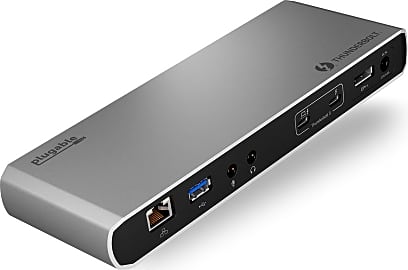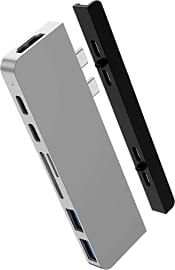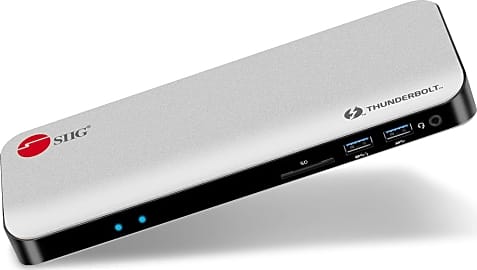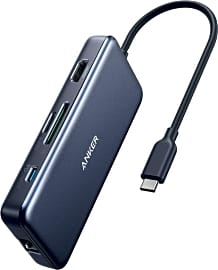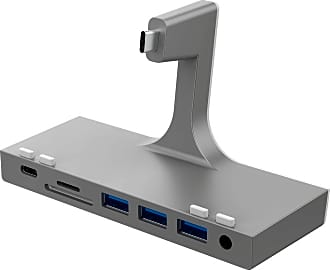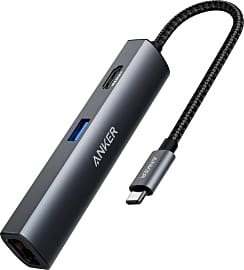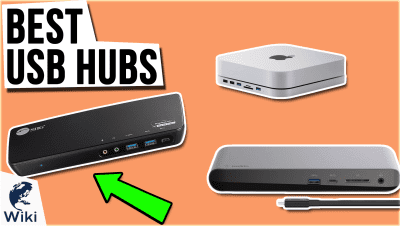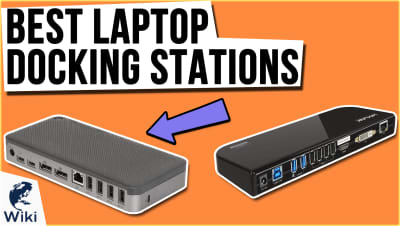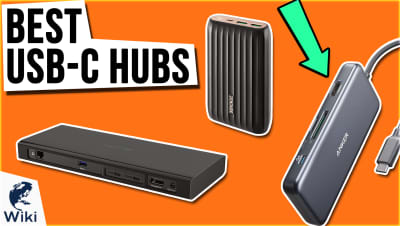The 10 Best USB Hubs For Macs

This wiki has been updated 37 times since it was first published in April of 2016. One drawback of Apple's increasingly streamlined designs is a lack of ports that once lined their desktop and laptop casings. Luckily, the latest data and charging protocols have made it easier than ever to add multi-device connectivity. Here are the best USB hubs for recent generations of MacBooks and iMacs, based on port selection, reliability, and power passthrough capabilities. When users buy our independently chosen editorial choices, we may earn commissions to help fund the Wiki.
Editor's Notes
November 12, 2020:
Our latest update to this list focuses on Macs that connect using the USB-C and Thunderbolt 3 protocols, as USB-A ports have been phased out of all subsequent Macbook Pro models since late 2016. Indeed, those who miss the USB-A port on their Macbook are the exact same folks who would benefit from one of the hubs in this ranking. While recent iMacs do still feature USB-A ports, they also have USB-C, while the latest ultra-portable Macbook Air has just two Thunderbolt 3 ports and nothing else; one of which is usually occupied by the charging cable.
With this in mind, we upgraded the Anker Portable to the Anker 5-in-1, as this not only uses a USB-C connector, but is encased in Apple's signature "Space Gray" tone of aluminum, and covers the basics as far as connectivity is concerned. Next, we selected the Sanho HyperDrive as it has the look and build-quality of an OEM unit, slotting into a Macbook Pro's two Thunderbolt-3 ports to provide a range of high-speed data transfer options.
Our next addition is the Plugable TBT3-UD1-85W, as every port on this compact and tidy device has the highest performing functionality in its class at the time of writing, although your machine does require Thunderbolt 3 to achieve its full 40 gigabits per second transfer speeds. The Sabrent Multi-Port Hub is another niche choice, as it is designed solely for use with USB-C-compatible iMacs, but acts as a front-facing extension of its rear ports, which, as any iMac owner will attest to, are not exactly conveniently positioned.
Finally, we included the Belkin Thunderbolt 3 Dock Pro, which has many of the high-performance features of the Plugable TBT3-UD1-85W but incorporates more connectivity options, including five USB-A ports, and this is especially useful if you use a lot of static peripherals in your setup, such as multiple displays or digital audio devices.
December 24, 2019:
By and large, the vast majority of quality USB hubs work great for both Windows and Mac computers, but there are a number of features and models that go especially well with Mac OS and Apple's highly streamlined devices. The Purgo TC401, for example, features a color and finish almost identical to that of a MacBook and it connects to the dual Thunderbolt 3 ports without any additional wires. The Satechi Clamp is a somewhat similar case, but instead of the MacBook it's built to clamp onto the 2017 iMac or iMac Pro to provide additional desktop functionality. Speaking of desktop use, while they're both quite expensive, the Plugable Docking Station and Siig JU Series are both remarkably full-featured, powered laptop docks that can add massive amounts of functionality, whether your computer is contained in a tower case or a tiny clamshell.
If you're mostly looking for additional Type-A ports, check out the Anker PowerIQ, which has 10. Seven of them are for transmitting data while 3 of them utilize the company's PowerIQ intelligent charging to keep sensitive devices' circuitry safe. Alternately, if you just want a couple basic expansion ports and SD card readers, and you're using a MacBook or MacBook Air, the Anker PowerExpand+ may be all you need. It is actually capable of charging the MacBook Pro, but not at full speed, and probably not fast enough to keep the battery from draining while you're using it. And if you need something simple and aren't terribly concerned with power passthrough, check out the Anker Portable and Sabrent Premium. They don't offer a ton of ports, but they're perfectly capable, and provide Apple fans with the Type-A connections that the newest laptops do not have built in.
Special Honors
Henge Docks Ostensibly named for the ancient set of stones erected for an unclear purpose by prehistoric pagans, the flagship vertical Henge Dock is designed to streamline your desk space by letting you integrate your MacBook with all your other devices and peripherals without even having to open the laptop. They also offer a decent selection of typical tethered docks as well as iPad and iPhone docking and charging stations. hengedocks.com
Satechi Multi-Port We promise that everything on our list will work with the right Apple device, but if you're an absolute stickler for purchasing Apple-endorsed products, you might like this one. It's not officially produced by the company, but it is a special edition that is sold only via their official store and isn't available through Satechi or any other online retailer, so you can rest assured that it will work with your device. apple.com
The First Serial Bus
The binary digits in each channel are transmitted in series, one after another, as a continuous stream of data.
Ever since engineers pioneered computers small enough to fit reasonably inside homes, users have been plugging in peripherals in attempts to add even more functionality to their systems. Of course, unlike a simple power cable, there's far more to data transfer than simple polarity; in fact, today there's a nearly endless list of connectors designed to move information from one device to another.
Eons ago, in the halcyon days of the Intel Pentium Processor and Windows 3.1, there existed a now-mythical artifact known as the serial port, a 9-pin connector used to communicate with certain peripherals such as printers, high-end keyboards, and dial-up modems. For those unfamiliar, "dial-up" was the type of telephony-based connection that cave-dwelling IT professionals used in the early Neolithic period of the internet, many generations before the emergence of Spacebook within the Twitterverse. While this connector was once ubiquitous on all of our (or our parents') home PCs, it's fallen mostly out of favor with users, though it is still often found in commercial applications.
But why is this archaic connector even worth bringing up? Because although it's been far surpassed by newer technologies, the "serial" moniker continues to describe how most external devices communicate. The binary digits in each channel are transmitted in series, one after another, as a continuous stream of data. This mimics the way that the more familiar Ethernet, Firewire, and increasingly confusing USB standards operate among today's modern hardware and software.
You'll Have To Be More Specific
While you might guess that the "S" in USB stands for serial, the first letter of the acronym makes a bit less sense. Some say that whenever they hear the word "universal," it often and ironically translates to "works with a limited selection of products." Considering that there are somewhere around a dozen or more different connectors that the term USB can refer to, that's not too far from the case here.
The interesting reason behind this is that the industry is currently engaged in somewhat of a transition from one of the most popular formats in history — the type-A plug — to an even more versatile and powerful design. This new interface offers vast potential for moving data and power between devices at blazing speeds, but it's also more than doubled the amount of classifications, adapters, sub-types, and proprietary instructions that advanced users need to know.
USB 3.1 Gen-2, only available over the new reversible connector, doubles the previous throughput at 10 Gbps.
We can look forward to this high-speed cable becoming commonplace, but these days, a majority of us still use devices that operate solely using type-A and micro-B, and in truth, those don't necessarily disappoint when it comes to speed. The first ultra-popular standard, 2.0, supports a theoretical maximum of 480 megabits per second, whereas 3.0 can technically reach speeds of 5 gigabits per second, 10 times faster than the previous iteration.
Then it gets a little more confusing.
Unscrupulous advertisers often refer to version 3.0 as version 3.1 Generation 1, but don't be fooled. USB 3.1 Gen-2, only available over the new reversible connector, doubles the previous throughput at 10 Gbps. And in the real world, none of them actually come very close to those maximums, due to the realities of electrical resistance, signal loss, and computational inefficiency. Nonetheless, type A is still very widely used for quite a few purposes.
But it is established that the new type-C connector is the fattest pipeline yet designed for home computing use. It's capable of throughput greater than what your PC will see at any single point within its architecture. This means you can pump trillions of polygons from a high-end GPU to a 60-inch TV at 4K resolution over one of these nifty cables, and you'll still have bandwidth left over to watch an HD movie as you casually obliterate your deathmatch opponents.
Almost as noteworthy as its remarkable top speed, the new physical format allows for the transmission of up to 100 watts of power to properly equipped downstream ports. The best chargers and portable devices use this Power Delivery standard to access the perfect amount of juice to run at full power, often while charging the unit faster than an AC adapter would.
The Beauty Of Apple Engineering
One of the main draws of Apple products is that they just work. From square one, users can access powerful software and install myriad applications while integrating a wide variety of peripherals. Indeed, Apple takes on a relatively involved role in ensuring general compatibility, with a more stringent licensing program than nearly any other developer. So right off the bat, we can be pretty confident that properly certified products will work with relative ease on iMacs, Macbooks, iPads, and various other popular items prefixed by a lowercase "i."
Beyond ease of use, another positive aspect is the brand's generally powerful and cutting-edge technology.
Beyond ease of use, another positive aspect is the brand's generally powerful and cutting-edge technology. For years, Apple popularized the Thunderbolt 2 protocol using the mini-DisplayPort connector, and at the time, it was one of the best ways to expand a portable device's functionality. Today's market is upgrading to Thunderbolt 3, a set of system instructions for using the new USB-C plug as an ultra-high-bandwidth serial bus. With the right active cable, this new protocol can move a whopping 40 gigabits per second, and it's currently the only way to experience the aforementioned ridiculous bandwidth that some of the newest hubs can utilize.
Thunderbolt 3 is inextricably linked to the future of many Apple products, mostly because of their somewhat controversial decision to eliminate all but a single USB type-C port on many of their newest devices. It's little surprise, given Apple's penchant for driving the innovation market, that this decision points to the general computing world's adoption of the new connector, and its transition into the ultra-fast USB era. Thanks to this new technology, there will forever be nearly twice as many hubs for Apple users to choose from, no matter which version suits your needs.




